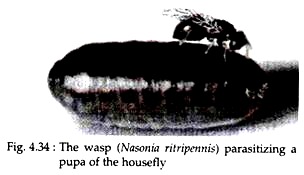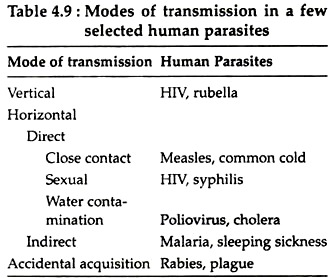In this article we will discuss about:- 1. Meaning of Parasites 2. Diversity of Parasites 3. Classification 4. Modes of Transmission 5. Host Specificity 6. Ecology 7. Responses to Host’s Immune Mechanism.
Meaning of Parasites:
Parasites are organisms that live and feed on another organism, usually, without killing it. The organism on which the parasite lives is called the host. Unlike the predator-prey and plant- herbivore systems, host-parasites interaction are generally prolonged affairs.
A heavy injection of parasites—the parasite load— eventually cause death of the host, either by weakening it or by causing disease. Further, a parasite also differs from a predator or herbivore in being much smaller than its host, so that often many parasites may live on a single host. Parasites generally grow faster than their host.
Diversity of Parasites:
As a mode of life, parasitism has evolved repeatedly. Its prevalence is seen in certain groups like viruses, bacteria, fungi, protozoans, flat-worms, round worms and some groups of crustaceans and insects. Only a small percentage of algae and higher plants are parasites. Among the vertebrates, parasitism is noticed among few cyclostomes and fishes.
ADVERTISEMENTS:
The lampreys attach themselves to other fishes and suck their body fluids. Small South American catfishes parasitise in the gill cavities of large catfishes, sucking their blood. The male ceratioid angler fish attaches itself on the body of the female and obtains nourishment by means of a placenta like fusion of their skin.
Classification of Parasites:
Parasites can be classified in various ways:
(a) Ectoparasites and Endoparasites:
ADVERTISEMENTS:
Ectoparasites live on the surface of their host, such as mosquito, bed bug, ticks, fleas etc. Endoparasites live inside the host’s body, such as viruses, blood flukes, malaria parasite etc.
(b) Micro parasites and Macro parasites:
Micro parasites multiply within or on the surface of the host by reproduction. They include viruses, rickettsiae, bacteria, fungi, protozoa etc.
Macro parasites:
ADVERTISEMENTS:
Macro parasites grow in or on the host but do not multiply within the body of the vertebrate host. They produce eggs or larvae that pass out of it and includes parasitic worms and arthropods. Micro parasites usually cause death to the host or the host may recover with the development of a relatively long-lasting immunity. The response of the host to macro parasites is more variable—depending generally on the parasitic load.
(c) Biotrophs and necrotrophs:
Biotrophs are the parasites that survive only on living tissue. Most parasites are biotrophs. Necrotrophs are the parasites that continue to live on the host even after causing its death. Example of necrotrophy are sheep blowfly (Lucilia cuprina) and the plant fungal disease which causes “damping-off”.
(d) Parasitoids:
Parasitoids are any of a number of insect species whose larvae live within and consume their host, usually another insect. There are some species, particularly in the orders Hymenoptera (bees, wasps and ants) and Diptera (flies) of insecta, that are parasitoids.
Their life cycle include features of both parasitism and predation. A typical parasitoid, after mating with a male, the female adult goes in search of a host, which will be used as a good food source by her offsprings. An example of parasitoid is given in Fig. 4.34.
Parasitoids may be ectoparasitoid or endoparasifoid. In ectoparasitoid, the female adult deposits eggs on the outside of the host, while in endo-parasitoid, the female lays the eggs inside the host body with the help of a long ovipositor. In both the cases the female must locate a host, subdue it if necessary and sometimes, carry it to a suitable location.
The female possesses adaptation similar to those of predators. The eggs subsequently develop into a larva which uses the host as a food supply. The larva, in case of endo-parasitoids, literally eats its way out of the host by destroying it in the process. The study of parasitoid, thus, occupies a central position in the development of ecological theory.
ADVERTISEMENTS:
Modes of Transmission of Parasites:
Transmission of parasites may be either horizontal or vertical (Table 4.9). Horizontal transmission is very common — it takes place among members of a population. Vertical transmission is less common and the mode of transmission is from mother to offspring.
Horizontal transmission takes place either directly or indirectly, mediated by a vector (mosquito, tsetse fly etc.) or an alternate host. Rarely, the route of transmission may be accidental acquisition via another species.
Host Specificity of Parasites:
Usually parasites are host-specific. Each parasite is restricted to one host species or to a few closely related ones, in each stage of its life cycle. Parasites have evolved a fine relationship with the host. Parasites generally do not kill their host as selection favours it, for killing the host may lead to its extinction.
Thus, a delicate balance is maintained which depends upon the adaptation of the parasite to its host environment. Any stress in the form of disease may change the internal environment of the host, disrupting the normal host-parasite balance and leading to the death of the host.
Ecology of Parasites:
The host is regarded as the habitat of the parasite. Each parasite occupies a specific site within the host, which is due to the habitat selection on the part of the parasites. The parasites are adapted for life in a highly limited, stable, but temporary environment.
For adaptation to such a habitat, the parasites have attained special features that are related to:
(i) The security and stability of the parasite’s life in a host, and
(ii) The uncertainty and hazards of the transfer.
Often interspecific competitions also occur inside the host’s body which results in the exclusion of a species from a site that it would otherwise occupy. For example, it may so happen that a tapeworm and a spiny- headed worm may both simultaneously occur in the same host. Both of them prefer the upper part of the intestine of rats. The spiny-headed worm displaces the tapeworm to a posterior site and it occupies its preferred site.
Hosts response to parasite attack:
The attack by the parasite results in the development of immunity in the host. The attacked organisms may serve as antigens, resulting in the host’s body in constructing defenses, specific for the particular pathogen.
The defenses includes:
(i) Production of antibodies and
(ii) Cell-mediated immunity.
Responses of Parasites to Host’s Immune Mechanism:
Successful parasites have designed several ways to counter their hosts immune mechanisms, which are as follows:
(i) Some micro parasites produce chemical factors that suppress the immune system of the host.
(ii) Other parasites produce surface proteins that mimic host antigens and thereby escape from getting noticed by the host’s immune system.
(iii) A few schistosomes elicit an immune response while entering the host. They do not succumb to antibody attack because they coat themselves with proteins of the host before they are outnumbered by the host antibodies. Subsequently, other parasites that may infect the host have to face a barrage of antibodies. Thus, competing parasites may be excluded.

